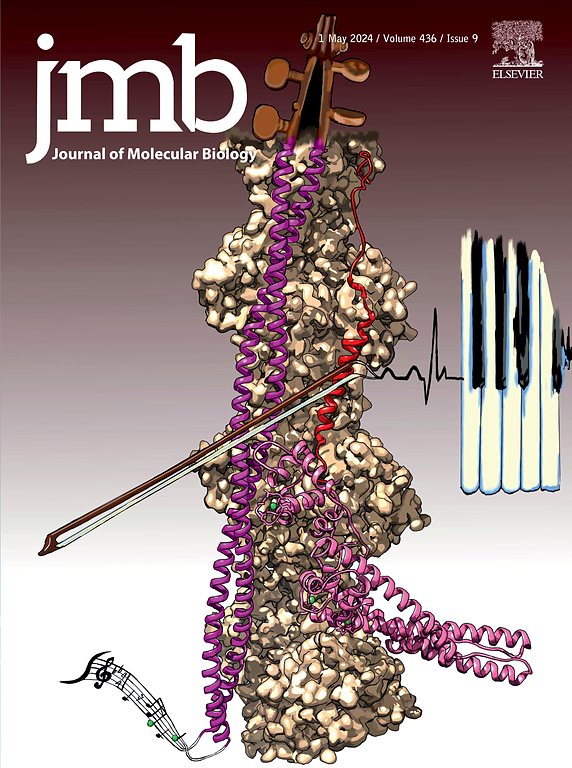神经型和非神经型drebrin的功能差异。
IF 4.7
2区 生物学
Q1 BIOCHEMISTRY & MOLECULAR BIOLOGY
引用次数: 0
摘要
肌动蛋白细胞骨架对神经元功能至关重要。Drebrin是神经元中关键的F-actin结合蛋白,与纤维的稳定有关。随着哺乳动物大脑的发育,drebrin表达模式从非神经元(drebrin E,胚胎)转变为神经元特异性亚型(drebrin A,成人),但这种转变的进化需求是谜。先前在细胞和体内的研究表明,drebrin亚型在神经元发育和功能中具有非冗余的作用,然而,缺乏对其分子水平的理解。在这里,我们使用诱变、散装溶液测定和延时TIRF显微镜来探测drebrin亚型之间的功能差异。我们发现drebrin A和E在功能上是不同的,它们抑制f -肌动蛋白解聚的能力是不同的。我们发现,这两种异构体都是肌动蛋白带刺末端的允许盖帽,然而,与非神经元drebrin e相比,drebrin A具有明显更强的盖帽活性。对观察到的差异进行分子水平的探索发现,神经元drebrin A的成人特异性外显子包含一个肌动蛋白结合界面,从而增强了其允许盖帽活性。值得注意的是,与drebrin e相比,神经元drebrin A的F-actin修饰对cofilin介导的切断具有更强的抵抗力。我们的研究结果为drebrin亚型之间的功能差异提供了新的分子水平的见解,加深了我们对神经元背景下细胞骨架调节的理解。我们的结果也有助于解释先前报道的与神经元drebrin亚型的沉默或敲除相关的数据。本文章由计算机程序翻译,如有差异,请以英文原文为准。

Functional Differences Between Neuronal and Non-neuronal Isoforms of Drebrin
Actin cytoskeleton is vital for neuronal function. Drebrin is a key F-actin binding protein in neurons which is linked to the filaments’ stabilization. As mammalian brain develops, drebrin expression pattern switches from non-neuronal (drebrin E, Embryonic) to neuron-specific isoform (drebrin A, Adult), but the evolutionary need for such a switch is enigmatic. Prior in cellulo and in vivo work suggested a non-redundant role of drebrin isoforms in neuronal development and function, however, molecular level understanding of it is lacking. Here we used mutagenesis, bulk solution assays, and time-lapse TIRF microscopy to probe for functional differences between drebrin isoforms. We found that drebrin A and E are functionally distinct and differ in their ability to inhibit F-actin depolymerization. We showed that both isoforms act as permissive cappers of the barbed end of actin, however, drebrin A has a significantly stronger capping activity, compared to that of the non-neuronal drebrin E. Probing for the molecular level insights on the observed differences revealed that the adult-specific exon in neuronal drebrin A contains an actin binding interface which enhances its permissive capping activity. Strikingly, F-actin decoration by neuronal drebrin A confers significantly stronger resistance to cofilin-mediated severing compared to that of drebrin E. Our results provide novel molecular level insights on functional differences between drebrin isoforms, which deepen our understanding of cytoskeletal regulation in the neuronal context. Our results also helps interpreting the previously reported data related to the silencing or knockout of the neuronal drebrin isoform.
求助全文
通过发布文献求助,成功后即可免费获取论文全文。
去求助
来源期刊

Journal of Molecular Biology
生物-生化与分子生物学
CiteScore
11.30
自引率
1.80%
发文量
412
审稿时长
28 days
期刊介绍:
Journal of Molecular Biology (JMB) provides high quality, comprehensive and broad coverage in all areas of molecular biology. The journal publishes original scientific research papers that provide mechanistic and functional insights and report a significant advance to the field. The journal encourages the submission of multidisciplinary studies that use complementary experimental and computational approaches to address challenging biological questions.
Research areas include but are not limited to: Biomolecular interactions, signaling networks, systems biology; Cell cycle, cell growth, cell differentiation; Cell death, autophagy; Cell signaling and regulation; Chemical biology; Computational biology, in combination with experimental studies; DNA replication, repair, and recombination; Development, regenerative biology, mechanistic and functional studies of stem cells; Epigenetics, chromatin structure and function; Gene expression; Membrane processes, cell surface proteins and cell-cell interactions; Methodological advances, both experimental and theoretical, including databases; Microbiology, virology, and interactions with the host or environment; Microbiota mechanistic and functional studies; Nuclear organization; Post-translational modifications, proteomics; Processing and function of biologically important macromolecules and complexes; Molecular basis of disease; RNA processing, structure and functions of non-coding RNAs, transcription; Sorting, spatiotemporal organization, trafficking; Structural biology; Synthetic biology; Translation, protein folding, chaperones, protein degradation and quality control.
 求助内容:
求助内容: 应助结果提醒方式:
应助结果提醒方式:


